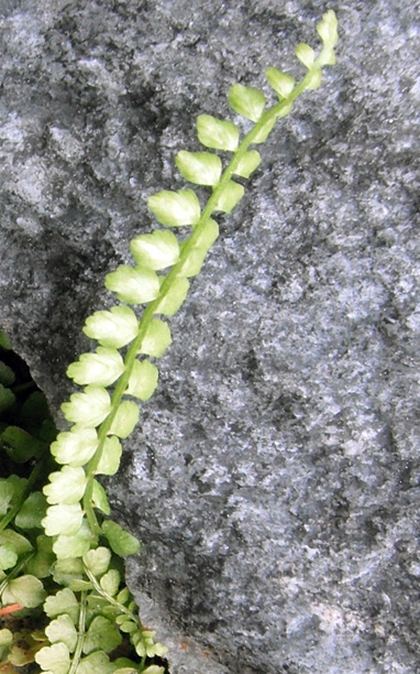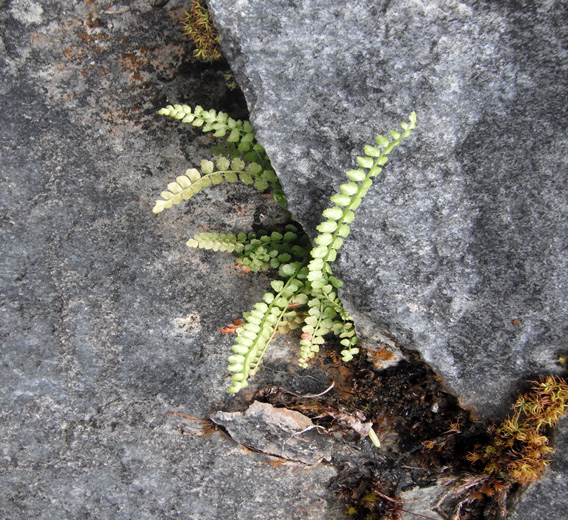Green spleenwort • Asplenium viride, A. trichomanes-racemosum
{Asplenon = 'without spleen', from a belief based on the doctrine of signatures which says that the spleen shape of the plant's sori means it can treat spleen ailments}
Identification
Green spleenwort is a deciduous fern with bright green stipes (stalks) and leaflets. Each frond — which is technically a leaf —is long and narrow, reaching up to 14 cm tall. The leaflets are oval or round, have rounded teeth, and are in opposite pairs near the base of the stipe before transitioning to alternating. The leaflets can become quite laden with sori, which form sausage-shaped lines following veins on the undersides of the leaflets. This species grows in dense clusters.
Habitat & Range
Green spleenwort grows in clusters in moisted, shaded crevices in limestone rock (or other basic rock types). It can be found at low to subalpine elevations, but is not a common species in British Columbia. It is found throughout much of western North America, as well as part of the northeast. Its circumpolar distribution means it is also found in parts of Eurasia.
Similar Species
The similar maidenhair spleenwort (Asplenium trichomanes), which is also found in coastal British Columbia, has purplish-brown stipes and opposite rather than alternating leaflets. Its leaves are firm and evergreen.
Green spleenwort is a deciduous fern with bright green stipes (stalks) and leaflets. Each frond — which is technically a leaf —is long and narrow, reaching up to 14 cm tall. The leaflets are oval or round, have rounded teeth, and are in opposite pairs near the base of the stipe before transitioning to alternating. The leaflets can become quite laden with sori, which form sausage-shaped lines following veins on the undersides of the leaflets. This species grows in dense clusters.
Habitat & Range
Green spleenwort grows in clusters in moisted, shaded crevices in limestone rock (or other basic rock types). It can be found at low to subalpine elevations, but is not a common species in British Columbia. It is found throughout much of western North America, as well as part of the northeast. Its circumpolar distribution means it is also found in parts of Eurasia.
Similar Species
The similar maidenhair spleenwort (Asplenium trichomanes), which is also found in coastal British Columbia, has purplish-brown stipes and opposite rather than alternating leaflets. Its leaves are firm and evergreen.
References
Asplenium viride Huds. In Klinkenberg, Brian. (Ed.). E-Flora BC: Electronic Atlas of the Plants of British Columbia [eflora.bc.ca]. Lab for Advanced Spatial Analysis, Department of Geography, University of British Columbia, Vancouver. Accessed 13/06/2016.
Pojar, J. and MacKinnon, A. (1992. Plants of Coastal British Columbia. Vancouver, BC: Lone Pine Publishing. P. 425.
Authors and editors of page
Kelly Fretwell (2016)
Asplenium viride Huds. In Klinkenberg, Brian. (Ed.). E-Flora BC: Electronic Atlas of the Plants of British Columbia [eflora.bc.ca]. Lab for Advanced Spatial Analysis, Department of Geography, University of British Columbia, Vancouver. Accessed 13/06/2016.
Pojar, J. and MacKinnon, A. (1992. Plants of Coastal British Columbia. Vancouver, BC: Lone Pine Publishing. P. 425.
Authors and editors of page
Kelly Fretwell (2016)





